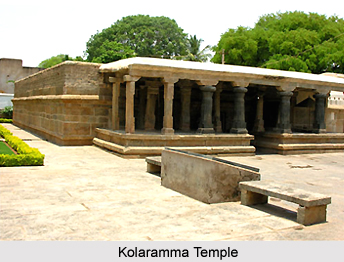 Kolaramma temple is built in Dravidian Vimana Style and dates back to the Western Ganga dynasty period. The temple has several Chola Dynasty renovations and they made additions in the 11th century, followed by the rule of Vijayanagara Dynasty in the 15th century AD. The Cholas made several inscriptions in the temple and the earliest inscription belongs to the period of Rajendra Chola I from 1012-1045 A.D.
Kolaramma temple is built in Dravidian Vimana Style and dates back to the Western Ganga dynasty period. The temple has several Chola Dynasty renovations and they made additions in the 11th century, followed by the rule of Vijayanagara Dynasty in the 15th century AD. The Cholas made several inscriptions in the temple and the earliest inscription belongs to the period of Rajendra Chola I from 1012-1045 A.D.
Kolaramma temple is built in typical South Indian architectural style using granite stones and is around 800 years old. The temple is L-shaped housing two shrines, one for Goddess Durga who is known as Kolaramma and another for Saptamatras. The main temple faces the east while the larger shrine faces the north. However, both of them share a common vestibule. Though the temple resembles a "mantapa", there are nearly 30 inscriptions in both Tamil language and Kannada language found in the temple complex.
The temple has some "tantric" rituals depicted and a unique depiction of the "tantric" goddess carrying a bow. The plastic art is another architectural feature at this temple. A slab with a battle scene depicted on it is now found on the front platform of the entrance to the temple. The heroic stone `Viragal` which is around four and a half feet tall belonging to the Western Ganga period is covered with relief work of horses, soldiers, elephants, celestial chariots and celestial nymphs.
Kolaramma temple is centrally secluded Hindu shrine receives devotees and architectural enthusiasts every year. Kolar can be reached through rail and road. Most of the trains, which go to Chennai and Kerala from Bengaluru, pass Bangarpet, the nearest railway junction to Kolar, which is famous for Kolar Gold Fields. From Bangarpet you can catch a bus to the Kolar town, which is 15 km away. The Kolar town is well associated to other places in Karnataka and Andhra Pradesh as well. The best time to have a vacation the temple is during March and April, when the Karage festival is held.
This article is a stub. You can enrich by adding more information to it. Send your Write Up to content@indianetzone.com



















